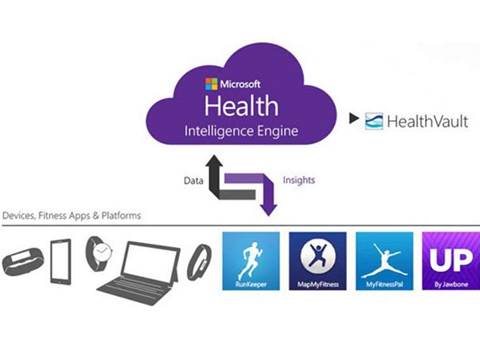When Microsoft launched its first smartband it also unveiled Health, its the cloud-based data analysis platform for crunching fitness data.
Microsoft Health collects data from Microsoft Band and other third party devices and apps, to provide "personal insights" to enable users to reach their fitness goals.
These insights include information on which exercises burned the most calories, how well you slept, and how long your body needs to recover from a training session.
Currently, the platform can collect and analyse data from RunKeeper, MapMyFitness, MyFitnessPal and Jawbone Up, as well as Microsoft Band and other unspecified smartwatches and mobile phones.
In the same way that Microsoft Band is a clear competitor to Samsung's Gear Fit, Microsoft Health is taking on Apple's HealthKit platform and Health app.
Microsoft Health vs Apple Health Kit
Both HealthKit and Microsoft Health feature APIs for developers to create apps that will share data with the respective platforms.
Apple HealthKit and Microsoft Health also both merge the data collected from these third party apps and present them in a usable fashion to users via a smartphone app.
However, there are also some significant differences between the two. Microsoft is angling very much to have as many third-party devices providing data to Health as possible.
“We are taking our first steps to empower people to achieve more with their health with the announcement of Microsoft Health ... and the first device to be powered by [it], the Microsoft Band," Microsoft said in a statement.
"This is just the beginning of a multi-year vision for Microsoft in the health & fitness and wearables category," it added.
Microsoft health: cross platform compatibility
Cross platform compatibility is another thing that really sets Micrsoft Health apart. As well as trying to draw in data from as many sources as possible, irrespective of their OS, the Health app will work on Android and iOS as well as Windows Phone.
While Apple's Health app collects data from a number of sources, it's locked to iOS. Samsung's entire wearables range is even less flexible, as it's locked not just to Android, but also to its own smartphone and phablet ecosystem.
An increasing number of third-party health linked which certain devices, such as those from Fitbit and Jawbone, are starting to appear on Windows Phone. However, aggregators are lacking and, even if like MyFitnessPal they do exist, they don't collect the variety of data Microsoft Health will.
Microsoft Health: cloud power
Microsoft Health uses the company's cloud infrastructure to crunch all the data collected from its own devices, including Microsoft Band, as well as data from third-parties, and turn it into something meaningful for the user.
By letting them know which exercises burnt the most calories or took the longest to recover from, they can tailor their fitness regime to suit their needs.
According to Microsoft, longer-term it can provide information such as whether eating breakfast helps performance or if the number of meetings they have in a day has any impact on restless vs restful sleep.
Microsoft Health: the verdict
It's clear that Microsoft Health isn't your standard health and fitness platform. It shapes up well, at least on paper, against Apple Health in particular, thanks to its interoperability with different OSes and devices.
Its cloud analysis looks like a real boon too, as it can seemingly draw together and spot correlations between different inputs, such as meal times and sleep, to inform users and potentially help them make better decisions for their health and wellbeing.
However, it remains to be seen how well it works in practice, with the service limited to the US for the time being.







_(21).jpg&h=142&w=230&c=1&s=1)
.png&h=142&w=230&c=1&s=1)



.jpg&w=100&c=1&s=0)
_(8).jpg&w=100&c=1&s=0)










